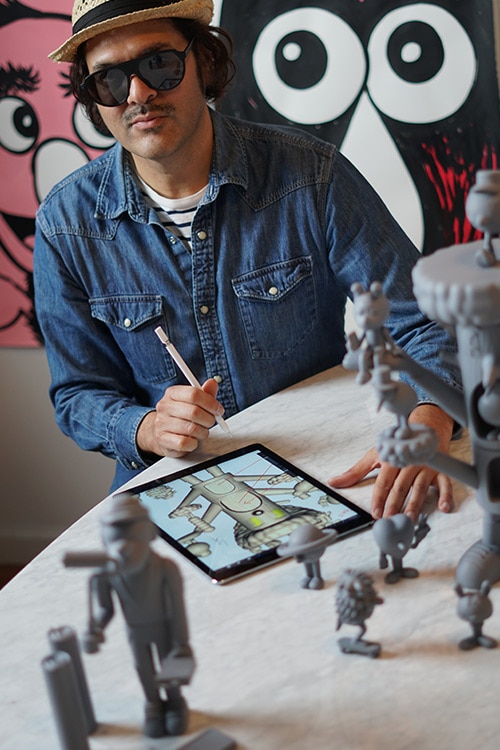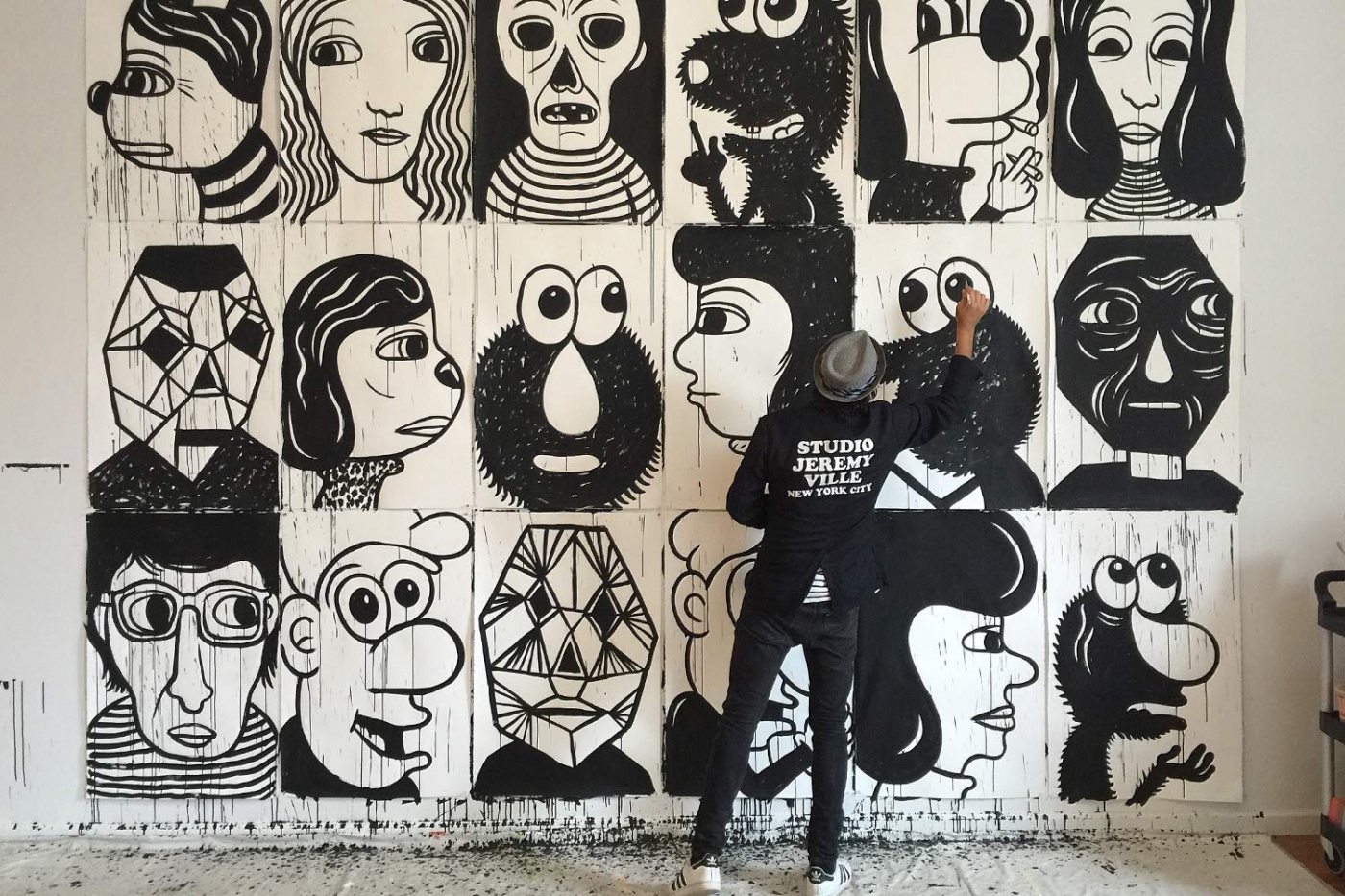Get Lost in the Whimsical World of Jeremyville
In a world filled with dysphoria, we need joy more than ever. New York-based artist-author Jeremyville’s uplifting Community Service Announcements (CSA) does just that—in the form of playful and witty illustrations accompanied by short, explanatory captions. Think effulgent colours, vivacious talking trees, puckish hamburger patties that can walk and a jaunty pastel pink bunny named Jethro. To date, his CSA project has shared over 2,000 messages of self-empowerment, love, human virtue and hope with the public through street art, public sculptures made with tromp l’oeil techniques and animation.
Despite not having a formal art education, the 44-year-old cartoonist has held exhibitions globally (like in the Andy Warhol Museum) and collaborated with illustrious brands like Converse, Kiehl’s, Lacoste and most recently, Zara in March. His success, though hard-earned, also stems from his indefatigable desire to change the world—one drawing at a time. Winsome yet emotive, Jeremyville deftly weaves in humour to broach issues like global warming, pollution, depression and dysfunctional relationships. If you are currently suffering from pandemic-induced anxiety or just down in the doldrums because social distancing is affecting your love life, Jeremyville is here to inject a much-needed shot of happiness into your life.
High Net Worth: How did Studio Jeremyville come about?
Jeremyville: It started as an engine to produce many different kinds of projects. For me, almost everything starts with an empty sketchbook and an endless pen, just spending time at a cafe, thinking, drawing and planning. The excitement is all about a new project, a concept, or a medium I haven’t explored before. An idea can manifest itself in any medium relevant to the project; it does not have to be constrained by only the mediums you know, or are familiar with. It’s always more exciting to leave your comfort zone to explore new mediums, and recently I’ve been working in 3D sculpture, animation, public speaking, fashion, fine art, and some fields of entertainment. My degree in architecture taught me that the process of getting an idea to its completed form is the important thing. And Studio Jeremyville was born from the need to create a defined set of systems to turn ideas into reality. Neil [Venkataramiah], Megan [Mair] and I are the founders, and we each have our own unique set of strengths and roles.
How has your art evolved since moving from Australia to New York City?
I’m more about the idea than the style, so as my ideas develop, the way they look also changes, to suit the idea. I don’t believe in one fixed visual style, it’s okay to always be in a constant state of change.

What do you hope to achieve with your art? I notice that there is always a message in there.
A genuine connection with our audience is everything. The visual style of my art is not as important as the idea and message. For example, with the CSA project, I wanted to create a series of simple images with deeper layers of meanings. The look of the CSA project was thus born from that need. The concept comes first, and later the art direction and style. My other projects like paintings, were determined by the concept and feeling I was trying to express. Overall though, there is a “Studio Jeremyville” feel running through all the work we do, but it’s not limited to one specific look or style. It’s more of a connection, an experience and a feeling.
Can you elaborate on the “feel” of your work?
My work has more to do with poetry and storytelling than it has to do with traditional art. The same way the lyrics and music of a song go together to create a feeling, that’s what I try to create: an emotion and an experience. My visual language is based on symbols, comics, surrealism, shapes, graphic abstraction, fonts, and generally refining elements to their essence. I’d rather take lines away from a piece of work, than add them in. It’s what I leave out of a drawing that says as much as what’s included.
How do you define success as an artist? Is it about producing great work or making money?
Success, to me, is the ability and freedom to always evolve and change as an artist, and more importantly, as a person. Money has never been a means of acquiring status, but rather to give me the freedom to grow and be brave in my career. Before 30, I never took vacations. I was always driven and worked non-stop. After I graduated from university, I never worked in any job besides my art practice. Any money I earned went to my growing studio. At 26, I also started investing in property. I bought places in growing inner city areas like Darlinghurst and Potts Point, and in the beachside suburb Bondi Beach, which were all quite undervalued at the time, but have since become highly sought-after areas in Sydney. You could say that real estate is my other passion, and a good way for an artist to create another passive revenue stream of income. I also used my first property as my art studio to lower my overheads, as I knew that by lowering my studio’s operating costs, I could create more net profit, and, in turn, invest that back into my art.
Artists often have muses. Do you have any?
My future self is my muse. It is the vision that I have for who I can and will be. I hold that image in my mind, and it’s my daily goal. I also developed an acronym, A.I.T. that summarises my own personal mantra, that just came to me on a cliff run from Bondi to Bronte beach several years ago. We should all develop our own beautiful life, and the systems we need to live it.
Where do you get your inspiration?
My collection of sketchbooks is a great source of inspiration, and I often refer to them to find kernels of ideas or half-developed drawings from years ago. I’ve maintained this sketchbook process since the age of 18, as it is the best way to capture the essence of my thinking.
Have you ever had to compromise on your artistic vision throughout your career?
No. That was never an option.
What sacrifices have you made to get to where you are today?
Frugality is my daily mission. I’m very careful about what I spend on and am always looking for ways to save money. I’ve also sacrificed many friendships over the years, as I’m not the easiest person to hang out with! I’d much rather be working or creating art. I would probably need to do a course in the art of doing nothing! Even during this stay at home period, I kept busy by initiating a landscaping project at Northport, on Long Island.
What are the biggest misconceptions about art?
People think that art is only for artists. However, art can be experienced and created by anyone on earth, as long as you have a unique view of the world, and are able to express it in a way that hasn’t been seen before.

What kind of art would you never make?
Art that does not have something to say, and art that is just a pretty picture. That’s boring to me. Also, anything that’s on-trend. Art should not be about trends—that’s what fashion is about. Art should inspire future trends, and then when it becomes a trend, we should move on and create new things.
Has quarantine changed or enhanced your art and creativity?
I’ve always spent countless hours on my own, so this is nothing new to me! It’s actually my natural state of being. Going out and interacting with the world is a strange thing to me. Being at home, drawing, cooking, gardening, running, lifting weights and working hard on projects is just another day in Jeremyville. Nothing much has changed. If anything, there’s more time to focus.
What are you reading now?
‘Lifespan’ by biologist Dr David Sinclair.
What are you drawing now?
A cover for the New York Times, some sketches for an upcoming exhibition in Shanghai, a new comic for the #JeremyvilleComicStories series and a drawing for Apple, coming out soon.
What are you playing with now?
I am playing with yeast, sourdough starters, flour, salt, water and time.
What are you listening to now?
I’m typing this in the sunshine in the new gravel garden at Northport, Long Island New York, so I’m listening to the birds chirping, bumble bees flying past, a distant dog barking and a lawnmower. I have a song playing: The Saints, “Just Like Fire Would”—it reminds me of the lonely process of creating art.
How would you describe yourself as a person?
I’m inherently quite lazy and have had to cultivate a strong work ethic by sheer will, but I always find ways to do things quicker and for less cost. I’m often my own worst enemy and I’m working on that daily. I feel that I’m always operating at about 8 per cent of my true potential, and that has been a source of daily frustration for me. I’m also quite optimistic, so that love I derive from life, translates into my passion for art, cooking, exercise, real estate, and healthy living. There are lots of opposites within me, and I’d describe myself as having a complex and contemplative, but upbeat personality. Sometimes I can be too self-absorbed, too impatient, and often say exactly how I feel. It’s a very Sagittarian trait! Lastly, I value truth, honesty, good manners, politeness, altruism, helping the community and others, and respecting all people from all socio-economic groups.


